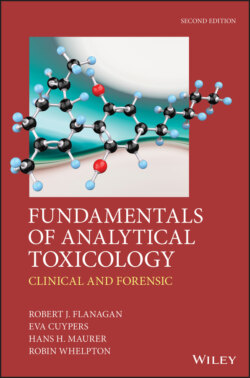Читать книгу Fundamentals of Analytical Toxicology - Robin Whelpton - Страница 9
ОглавлениеPreface
The analytical toxicologist may be required to detect, identify, and in many cases measure a wide variety of compounds in samples from almost any component of the body or in related materials such as residues in syringes or in soil. Many difficulties may be encountered. The analytes may include gases such as carbon monoxide, drugs, solvents, pesticides, metal salts, and naturally-occurring toxins. Some poisons may be individual chemicals and others complex mixtures. New drugs, pesticides, and other substances continually present novel challenges in analysis and in the interpretation of the results of the analysis. The analyte might be an endogenous compound such as acetone, or an exogenous compound such as a drug and/or metabolite(s) of the drug, whilst the sample matrix may range from urine to bone.
Many biological samples contain muscle, connective tissue, and so forth, which may have to be separated or degraded prior to an analysis, as well as a multitude of small and large molecular weight compounds. The concentration of the analyte to be measured can range from g L–1 (parts per thousand) in the case of blood ethanol to μg L–1 (parts per thousand million) in the case of plasma digoxin, and even ng L–1 (parts per million million) in the case of the potent opioid carfentanil. The stability of the analytes in biological samples also varies considerably, ranging from a few minutes for protease sensitive peptides and esters such as aspirin and diamorphine, to several years for some other drugs and pesticides.
This book aims to give principles and practical information on the analysis of drugs, poisons and other relevant analytes in biological and related specimens, particularly clinical and forensic specimens, i.e. it is a ‘toolkit’ in modern parlance. As such, this volume extends the scope of the World Health Organization (WHO) basic analytical toxicology manual1 and builds on the success of the first edition of this work that appeared in 2007.2 Moreover, it is intended to complement Dr Randall Baselt's Disposition of Toxic Drugs and Chemicals in Man (Edition 12. Seal Beach: Biomedical Publications, 2020), which remains the seminal reference work as regards the interpretation of analytical toxicology data.
A major difficulty in writing any textbook is deciding on the order of presentation. Having taken account not only of reviewer comments on the first edition, but also of the advances in analytical methods on the one hand, and the range of analyses that may now be required on the other, the material has been updated, expanded and presented in a new order. However, much of the discussion of the historical development of analytical toxicology present in the first edition has been removed to save space. On the other hand, some discussion of more traditional methods such as thin-layer chromatography has been retained for the simple reason that such methods are still used in many parts of the world.
After providing some background information, Section A outlines basic laboratory operations (aspects of sample collection, transport, storage, and disposal, use of internal standards, method implementation/validation, quality control and quality assessment, staff training, laboratory accreditation, etc.) and basic methodology ranging from simple colour tests through spectrophotometry to immunoassay and enzyme-based assays. Section B discusses separation science in detail (chromatography and electrophoresis, mass spectrometry, and ion mobility spectrometry). Section C reviews xenobiotic absorption, distribution and metabolism, and pharmacokinetics. Section D aims to unify this material and discusses point-of-contact testing, laboratory-based substance misuse and general toxicology screening, therapeutic drug monitoring, and trace elements and toxic metals analysis. The section concludes with a general discussion on the interpretation of analytical toxicology results.
Notes
1 1 Flanagan RJ, Braithwaite R, Brown SS, Widdop B, De Wolff FA. Basic Analytical Toxicology. Geneva: WHO, 1995; available at www.who.int/ipcs/publications/training_poisons/analytical_toxicology.pdf
2 2 Flanagan RJ, Taylor A, Watson ID, Whelpton R. Fundamentals of Analytical Toxicology. Chichester: Wiley, 2007
